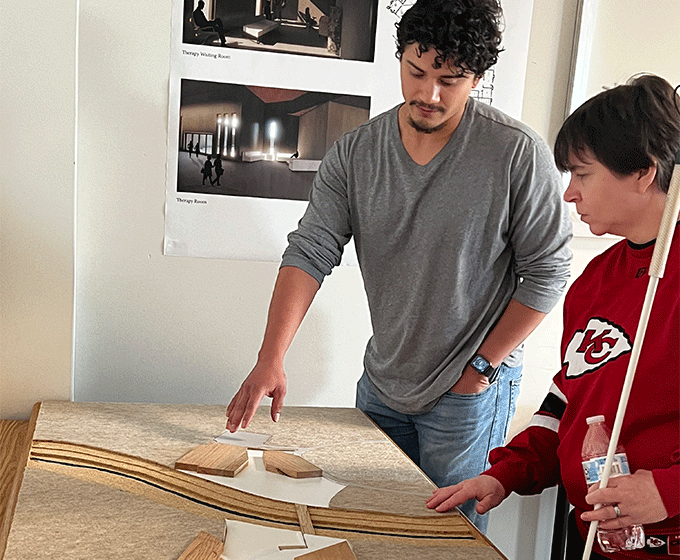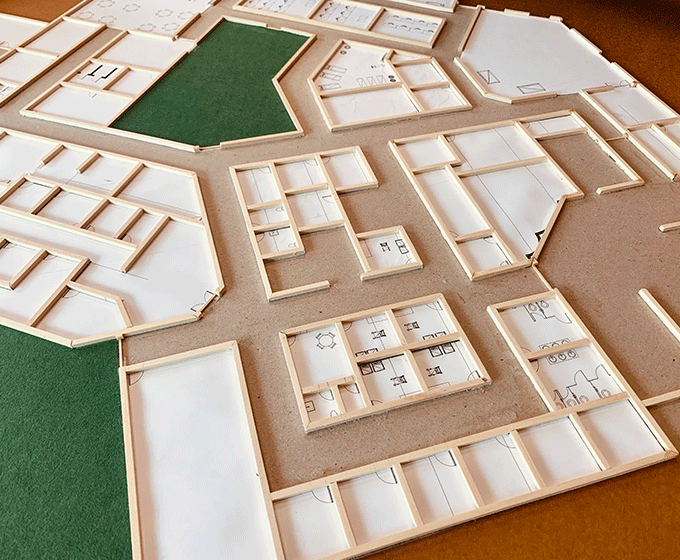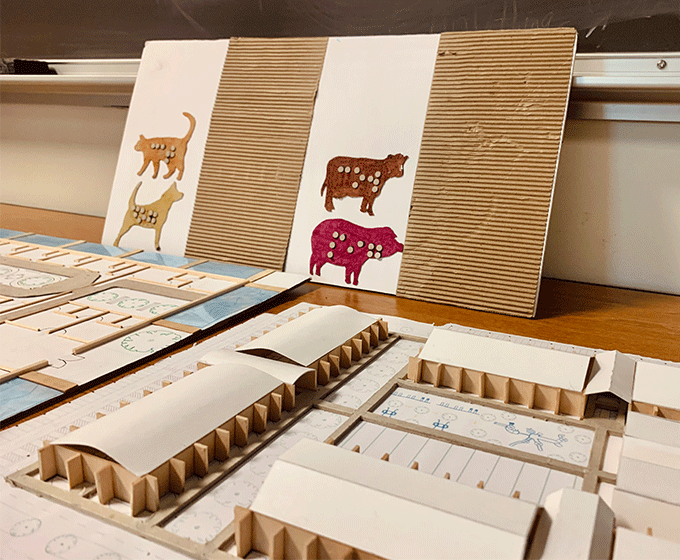
UTSA architecture students recently guided a visually impaired visitor through their designs.
APRIL 27, 2023 — On a recent Wednesday, UTSA architecture students prepared for visitors who would soon review their designs. They helped each other tape architectural renderings on the wall and neatly align corresponding models of their floorplans on tables.
This review was different for the group. Something important was on the line.
The class, led by Neda Norouzi, an assistant professor in the UTSA School of Architecture and Planning, has been collaborating with the American Institute of Architects (AIA) Center for Architects at San Antonio and disABILITYsa, a local nonprofit organization advocating for people with disabilities, to design a health center for people who are blind or visually impaired.
The course encourages students to practice evidence-based design and gives them experience using architecture as a tool to apply in real word settings.
Students are also gaining lessons in compassion, empathy and the impact design can have on people, Norouzi explained.
“We are interviewing with local San Antonians who are visually impaired or blind to better understand their needs from the built environment,” Norouzi said. “The data collected from these conversations are being used as the foundation of students' design.”
Wendy Walker, president of the San Antonio Chapter of the National Federation of the Blind Texas, traced her fingers along the raised floorplan where walls would be built as students described the layout. She provided the students with feedback on architectural solutions that could be improved and the design elements that she found especially innovative.
“I didn’t want to over-design. I wanted to design an experience in itself,” said Justin Joyce, a senior architecture student. “I wanted to give people independence and control of their movements.”
His project, “Touch of Echo,” seeks to give independence by using simplistic forms of wayfinding, a method that guides people through physical environments and enhances their perception of a space. He used texture, sound and artificial intelligence as the three main architectural features for the health campus he designed.
Joyce incorporated wayfinding in the form of a textured wall to help individuals decipher which direction they are heading by moving their hand either along the smoother edges, which led further into the building, or along the sharp edges that indicate the exit is nearby.
He found his inspiration among a group of rocks settled in San Pedro Creek. Joyce noticed how one side of the rocks was polished smooth but rough on the other side where the stream had carved a unique texture.
“I pictured my hand grazing these rocks and I could tell which way I was going depending on the texture. That inferred my design. This is my first exploration into universal design. It’s another dimension of a puzzle we were already learning in previous studios,” Joyce said.

Universal design (UD) is defined as the development of products and environments that are usable by all people, to the greatest extent possible, without the need for adaptation or specialized design.
Although the concept of universal design is well-documented, the unique design needs of persons who are blind or partially sighted have not always been fully considered or incorporated into the built environment, according to the World Blind Union.

Melanie Cawthon, cofounder and executive director of disABILITYsa, said the experience for students is important, even if their paths don’t lead to a career that focuses on designs for people who are blind or visually impaired.
“On a scale from 1 to 10, it’s 10. They’re helping put focus on part of the population that has been left out of the conversation. Design and programs that are inclusive take planning and knowledge so when we do include that in the educational system, we don’t miss out on those opportunities to be inclusive,” Cawthon said.
The students will present their final projects on May 3 at the Center for Architecture, located at 1344 S Flores St., from 4 to 6 p.m.
UTSA Today is produced by University Communications and Marketing, the official news source of The University of Texas at San Antonio. Send your feedback to news@utsa.edu. Keep up-to-date on UTSA news by visiting UTSA Today. Connect with UTSA online at Facebook, Twitter, Youtube and Instagram.
Move-in Day is an exciting time for incoming students. Students living in Alvarez Hall (2nd and 4th), and Chisholm Hall are moving in on August 19. The UTSA Housing and Residence Life (HRL) team looks forward to welcoming you all and helping you settle into your room.
Alvarez Hall and Chisholm HallMove-in Day is an exciting time for incoming students. Students living in Chaparral Village move in from August 20-21. The UTSA Housing and Residence Life (HRL) team looks forward to welcoming you all and helping you settle into your room.
Chaparral VillageMove-in Day is an exciting time for incoming students. Students living in Laurel Village move in on August 22. The UTSA Housing and Residence Life (HRL) team looks forward to welcoming you all and helping you settle into your room.
Laurel VillageThe College of Sciences welcomes our newest Roadrunners to UTSA at VIVA Science! This interactive event connects students with faculty, staff, student leaders, and peers while highlighting the opportunities available across the College.
Outdoor Learning Environment 2 (OLE), Flawn Building, Main CampusWe're excited to welcome the new class of UTSA College of Liberal and Fine Arts (COLFA) students to campus! Move In To COLFA is strongly recommended for new students in COLFA because it gives you the chance to learn about the Student Success Center, learn how to do college successfully and meet new friends.
Galleria (MH 2.01), McKinney Humanities Building, Main CampusBuild connections with your Alvarez College of Business peers and learn more about the Career Compass program! This opportunity will provide fun interactions, giveaways and a chance to meet your next friend!
Richard Liu Auditorium (BB 2.01.02,) Business Building, Main CampusCelebrate the end of summer and the start off a great fall semester with The Housing Block Party! This event will have live music, carnival-style treats, artists, games, and activities galore. Come and join us for a night of fun!
Multipurpose Room/Lawn, Guadalupe Hall, Main CampusThe University of Texas at San Antonio is dedicated to the advancement of knowledge through research and discovery, teaching and learning, community engagement and public service. As an institution of access and excellence, UTSA embraces multicultural traditions and serves as a center for intellectual and creative resources as well as a catalyst for socioeconomic development and the commercialization of intellectual property - for Texas, the nation and the world.
To be a premier public research university, providing access to educational excellence and preparing citizen leaders for the global environment.
We encourage an environment of dialogue and discovery, where integrity, excellence, respect, collaboration and innovation are fostered.